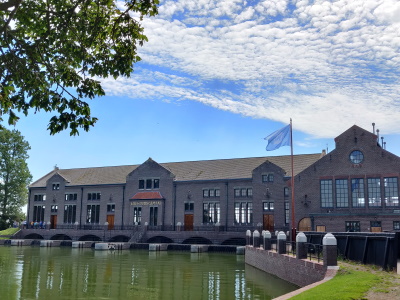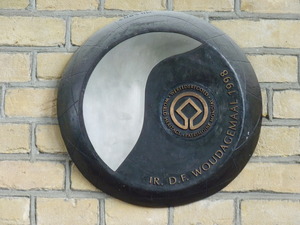Ir. D.F. Woudagemaal

The Ir.D.F. Woudagemaal (D.F. Wouda Steam Pumping Station) is the largest steam-pumping station ever built and is still in operation.
Opened in 1920, it used the most advanced steam technology for water management. It was developed to prevent flooding in the low-lying areas of Friesland. The site consists of the pumping station, in- and outlet sluices, the drainage canal, and a series of sea dykes. It set the standards for hydraulic engineering around the world.
Community Perspective: the machinery is kept in excellent condition by volunteers, who also act as enthousiastic, detail-oriented, and not-always-perfect-English-speaking guides. There’s a visitor center with a good introduction video as well, and you can admire the large engine hall which is a fine example of the Amsterdam School of Architecture.


Map of Ir. D.F. Woudagemaal
Community Reviews
Tony H.

The odd name of this WHS has always intrigued me so I was very happy to finally visit Ir. D.F. Woudagemaal in April 2024. The parking lot of the steam pumping station was quite empty when I arrived on a Thursday afternoon. I arrived by car but I could imagine it's easy to arrive here by public transportation too, as the pumping station is right at the edge of the lovely town of Lemmer. The parking lot is few hundred metres away from the station but you'll see it already from the road. When you arrive you'll first enter the ticket/souvenir shop. Just like earlier on the same day at Schokland, the staff seemed bit confused to see non-Dutch visitor showing up. Besides the tickets, I picked up some brochures about Friesland region, they had quite good selection of them!
After buying the tickets you'll be asked to go to the futuristic looking visitor centre where a guide will be waiting for you. You first enter a room with huge picture of the pumping station that is made up of pictures of other World Heritage Sites! Quite fun idea! My English-speaking guide was already waiting for me and a group of Dutch visitors had their own guide already giving a tour to them. The visitor centre has a restaurant with great views over the fields and the IJssel Lake. My guide gave me a brief introduction of the pumping station's history inside the visitor centre and then we were quickly out to explore the station itself.
I was very positively surprised how the pumping station looked inside. I was waiting for old dirty machinery but everything is very clean and very well kept. The guide was explaining very well how the pumping station works and what machine is used for what purpose, but he seemed to misunderstood every question I had and generally the private tour was bit awkward. Anyway, I had not looked too much information about the station beforehand so that I could learn more there and I didn't know the pumping station was so "new", I always thought it was from the 1800's, and that it was fully operational until very recently. The architecture is also very beautiful inside the main hall.
After the tour was over, I checked out the exhibition at the visitor centre. It was only in Dutch, which was quite disappointing considering how well managed the rest of the visitor experience was. After last look of the pumping station I left the site and went to enjoy a late lunch in the town of Lemmer. Ir. D.F. Woudagemaal is one of those Dutch WH sites that have a reason to be on the list but it's not the most exciting place to visit, unless you're into steam machinery or water management.
Michael Turtle

This is a fantastic little site - well away from the main cities of the Netherlands so I'm sure the average tourist doesn't come here or even know about it.
The pumping station can still be used but it's just for emergencies now so you get to walk through the whole thing and see the machines from the inside and the building from the outside. There's an excellent and modern visitors centre where you start and you'll need to go with a guide (included in the ticket).
It's quite a beautiful building and learning about the technology is fascinating. Really worth the trip.
Read more from Michael Turtle here.
Clyde

I visited this site on a cold sunny morning in April 2013. I was there at 10am and followed a guide who explained in detail how the steam pumping station works. The 3D video showing a footage of the Wouda in operation is quite interesting as is the informative film on the small screen before turning to the cafeteria. The UNESCO certificate can be seen in the office only through the glass doors. Strangely enough it is quite hidden and I only saw it by chance. It is one of the most interesting industrial heritage sites I've been to and perfect to combine with Schokland and/or the Rietveld Schroder House.
Rama Ramanathan
Today I drove about an hour to get to Lemmer to visit Woudagemaal (“Wouda”), the world’s largest steam-operated pumping station. It was a bleak day – the forecast was zero chance of seeing the sun and ninety five percent chance of experiencing rain. Both limbs of the forecast proved to be true.
It was wet all the way, visibility was poor and the water levels in the canals along the country roads were high. I’m glad I told the GPS to avoid the highways, because without such an acute encounter with the water levels, I might have missed the wonder of the pumping station. Every single day, pumping stations keep the Netherlands from being submerged.
The decision to build Wouda, to solve flooding woes and to reclaim land, was made in 1913. Construction began in 1916. When pumping started in 1920, it was powered by coal which came via ships from the South – and was moved to the boilers on wheelbarrows.
It has enormous capacity: in 1 minute it can drain a football (soccer) pitch flooded with 2 feet of water. For engineers, that’s 4,000 m3 per minute or about 6 million m3 per day
Our tour guide was an older man who loves showing off the pumping station and clearly knows his stuff – the kind of guide I always appreciate and hope one day to be. However his English, though far better than my Dutch, wasn’t up to par. Despite translation help from two other visitors – a young Dutchman and his girlfriend – I may not have got it right.
Until 1967, men (the guide said ‘poor fishermen’) pushed the coal on wheel barrows, across a paved yard, to the boilers; other men shovelled it into the burners. In 1967 the power source was converted to heavy fuel oil, with provision to start and stop with diesel.
The ability to use diesel is essential: you have to start the boilers to heat the heavy oil with steam so that it will flow; then, when you shut down the boilers, you have to ensure the pipes aren’t filled with heavy oil which, after it cools, can’t be moved by a pump.
The pumping station is housed within a dyke. It is equipped with 8 centrifugal pumps driven by 4 steam engines. The engines are driven by superheated steam (320 deg C) and are fitted with 6.5 metre diameter x 6.5 ton flywheels. Perhaps it’s not a coincidence that the normal total operating capacity of the pumps is 65 m3 per second.
The 4 boilers are identical. Of the flame-tube type, each has a diameter of 3.6 metres, a length of 5.3 metres and a heating surface of 220 m2. Two boilers are sufficient to maintain the engines at the optimum speed of 90 r.p.m. A third boiler must be fired if the maximum speed of 105 r.p.m. is required. The fourth boiler is kept on standby, in reserve.
I was impressed by the housings of the centrifugal pumps. I thought I saw a flash of appreciation on the guide’s face when I asked about them. If I understand correctly, the housings are made of sections fabricated from thick sheet steel in Utrecht and assembled and riveted together on site. I couldn’t tell how the impellers were fabricated.
I was also impressed by the gantry which can lift up to 9.2 tons. It has no I-beam. It’s still not electrically powered, either for horizontal or for vertical movement.
The red brick chimney has a diameter of 6.25 metres at the bottom and tapers to 3.0 metres at the top, 55 up.
The inlets to the pumps have strainers made of teak wood from Indonesia.
The pumps are operated 3 times a year: twice for the benefit of students and visitors and a third time, typically in February, to prevent Friesland from flooding.
The station is managed by the Friesland water authority. When needed, they just call in staff – who drop whatever else they are doing and come to the station to run it. Must be the highlight of the year for them – I know it would be for me.
In 1998 the Woulda pumping station was ‘inscribed’ on the UNESCO World Heritage List (# 867) for the following reasons:
Criterion i: The advent of steam as a source of energy provided the Dutch engineers with a powerful tool in their millennial task of water management, and the Wouda installation is the largest of its type ever built.
Criterion ii: The Woulda pumping station represents the apogee of Dutch hydraulic engineering, which has provided the models and set the standards for the whole world for centuries.
Criterion iv: The Woulda pumping installations bear exceptional witness to the power of steam in controlling the forces of nature, especially as applied to water handling by Dutch engineers.
After visiting Woulda I have a better appreciation of the dependence of the Dutch on mastery of water engineering – not just the technology, but also the administration of it.
Wouda is a living example of the estimated 700 steam powered pumping stations which kept the feet of the Dutch from getting wet from 1900 to 1910.
Wouda is not only the largest steam powered pumping station ever built. It is also in mint condition and still up to the task.
----
I wrote about my visit on my blog at write2rest.blogspot.com
Els Slots

My already quite dirty car took some more dust when I tried to get to the Woudagemaal. At the moment, the surrounding dikes are raised by one meter to be able to continue withstanding the water.
For a look inside you have to take a tour. This is very worthwhile because you get some idea of how this big complex works (although I didn't grasp the whole story). Very remarkable is that every machine inside is in very good and blinking condition. The people who work here obviously take great care and pride in preserving this industrial heritage.
Besides the impressive machinery, the building that they are housed in is also worth a special look. The large engine hall is a very fine example of the Amsterdam school of architecture.
On my second visit (together with WHS colleague Christer Sundberg) we were given a private tour by Theo Kuilboer. The complex technical structures made much more sense to me thanks to his explanations.
David Morton
This pumping station will be of interest to people of all ages as it helps to understand the problems the people of the Netherlands have with dealing with the problems of rain in an area situated below sea level. I found the visit very interesting and with an entry price of 5 Euros (August 06) it was good value. The entrance is sign posted off the N359 just on the edge of Lemmer. You have to visit with an on site tour guide (English speaking)this is for safety reasons and they give an amazing amount of information. Tour times are about every hour starting on the half hour excluding lunch times.
If a lot of rain has fallen in the previous days then the pumps may be in operation and will make your visit an even greater experience.
Ian Cade

The pumping station is absolutely pristine, the machines are spotless and still ready to start up when called into action, as they are in for a few weeks in winter. The main building is finished to a very high quality and the upkeep of the machines is fantastic. This is a huge pumping station yet when it is up and running it only needs about 3 or 4 people to keep it going.
The volunteers that gave the tours were really great and helpful and obviously enjoyed giving up their free time to teach people about the site, and as with everywhere in the Netherlands their grasp of English was shaming good.
I am not sure however if this site is really of outstanding universal value, whilst I greatly appreciate industrial aspects of the list I am left wondering if being the ‘world’s largest steam driven water pumping station’ is significant enough to merit the status of World Heritage. The site contrasts with the Derwent Valley Mills in England where the significance was much greater but the upkeep of the mills was nowhere near as impressive.
I visited the site after a short drive (25min) from Shockland. It is just outside the town of Leemer in southern Friesland, and to my surprise was well signposted from the A6 motorway. Leemer provides a nice place to get something to eat, either in a restaurant or grab some food in a supermarket and sit on the really lovely sandy beach.
On the whole I felt this site is only really worth a quick visit to tick it off or if you have a love of steam, in which case a visit in winter when the machines are in action would probably be very worth while.
Theo Kuilboer
Some time ago I visisted the more than 80 years old pumping station in mid-winter.
The machines looked magnificent, eager to be started up again. My companions also
enjoyed the trip very much.
Since then there have been significant changes:
- the site was added to the World Heritage List in 1998
- since July 2001 there is an enthousiastic group of volunteers giving a guided tour
- in the tour included is a 11 minutes video
- when in autumn or winter the pumps are needed, there is daily service of guided tours
from 10 am - 18 pm
- since Feb 2002 there is a website operational: www.woudagemaal.nl
Community Rating
- : WalGra Coppi Sandra! Rafał Kałczuga
- : Christravelblog Rodinia
- : Juropa Philipp Peterer PabloNorte Sebasfhb Dirk-pieter Christoph Jeanne OGrady ChrisDorn
- : Thibault Magnien Jan Zimmermann Jakob Frenzel Ih0000 Dolemite92 Zhenjun Liu Zach Antonio J. Simonh Krijn
- : Zoë Sheng Randi Thomsen Alexander Lehmann Roman Raab Joyce van Soest Peter Alleblas Kurt Lauer Cezar Grozavu ReallyDeepThoughts Mikko Craig Harder SirLoydd CyBeRr Frederik Dawson J. Stevens David Berlanda Mstrebl1990 Ilya Burlak Martina Rúčková Ralf Regele
- : Wojciech Fedoruk Gary Arndt George Gdanski Clyde Ivan Rucek Shandos Cleaver Peter Lööv BobSmithseestheworld Svein Elias Hubert Dwight Zehuan Xiao Tony H. Astraftis
- : Thijs van den Berg Els Slots Stanislaw Warwas Dorejd Adrian Turtschi Daniel C-Hazard Allnamesused Sncjob Assif
- : Solivagant Nan Philipp Leu Patphilly Anthonynice Caspar Dechmann DavidS Argo Yevhen Ivanovych
- : Ian Cade Walter Tarquinio_Superbo
- : Lukasz Palczewski
Site Info
- Full Name
- Ir.D.F. Woudagemaal (D.F. Wouda Steam Pumping Station)
- Unesco ID
- 867
- Country
- Netherlands
- Inscribed
- 1998
- Type
- Cultural
- Criteria
-
1 2 4
- Categories
- Structure - Civic and Public Works
- Link
- By ID
Site History
1998 Inscribed
Site Links
Unesco Website
Official Website
Related
In the News
Connections
The site has 13 connections
Art and Architecture
Constructions
Geography
Human Activity
Science and Technology
Timeline
Visiting conditions
WHS Hotspots
WHS Names
WHS on Other Lists
World Heritage Process
Visitors
228 Community Members have visited.
The Plaque
 (photo by Clyde)
(photo by Clyde)